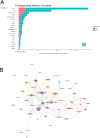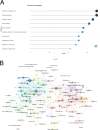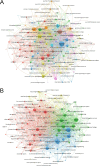Trends and emerging frontiers of mesenchymal stem cells in intervertebral disc degeneration: a bibliometric analysis (2000-2024)
- PMID: 40636356
- PMCID: PMC12237901
- DOI: 10.3389/fmed.2025.1601806
Trends and emerging frontiers of mesenchymal stem cells in intervertebral disc degeneration: a bibliometric analysis (2000-2024)
Abstract
Background: Intervertebral disc degeneration (IVDD) is a major global cause of disability, and mesenchymal stem cell (MSC) therapy offers a promising regenerative solution by targeting the root causes of degeneration, unlike conventional symptom-focused treatments. This bibliometric analysis explores trends and emerging research areas in MSC applications for IVDD.
Methods: A comprehensive literature search was conducted in the Web of Science Core Collection database, covering publications from 2000 to 2024. Bibliometric and visualized analysis was performed using VOSviewers, CiteSpace and the R package "Bibliometrix."
Results: This bibliometric analysis reviewed 931 articles, revealing an overall upward trend in publication activity. Leading authors included Sakai Daisuke, Grad Sibylle, and Alini Mauro. China and the USA led in publication volume and citation counts, while the United Kingdom achieved the highest average citations per publication. The University of Pennsylvania and Zhejiang University were the most productive institutions. Key journals included Biomaterials, Spine, and Tissue Engineering Part A. Earlier core keywords primarily focused on foundational concepts such as "gene expression," "articular cartilage," "anulus fibrosus" and "extracellular matrix." Recent keyword bursts include "activation," "autophagy," "extracellular vesicles," "apoptosis," "exosome," and "oxidative stress."
Conclusion: This bibliometric analysis revealed key research focuses on foundational biological mechanisms, translational applications, and addressing specific challenges in the use of MSC for IVDD. Future research is likely to focus on optimizing MSC functionality, developing cell-free therapies such as extracellular vesicles, and targeting the molecular mechanisms involved in disc degeneration and regeneration.
Keywords: CiteSpace; VOSviewer; bibliometric analysis; intervertebral disc degeneration; mesenchymal stem cells; regenerative medicine.
Copyright © 2025 Zhao, Li, Cheng, Xu, Bai, Yu, Liu, Yin and Wu.
Conflict of interest statement
The authors declare that the research was conducted in the absence of any commercial or financial relationships that could be construed as a potential conflict of interest.
Figures








Similar articles
-
A bibliometric analysis of research trends in mesenchymal stem cell therapy for neonatal bronchopulmonary dysplasia: 2004-2024.Front Pediatr. 2025 Jun 3;13:1558301. doi: 10.3389/fped.2025.1558301. eCollection 2025. Front Pediatr. 2025. PMID: 40530182 Free PMC article. Review.
-
Data-driven trends in critical care informatics: a bibliometric analysis of global collaborations using the MIMIC database (2004-2024).Comput Biol Med. 2025 Sep;195:110670. doi: 10.1016/j.compbiomed.2025.110670. Epub 2025 Jun 27. Comput Biol Med. 2025. PMID: 40580617
-
Research status, hotspots and perspectives of artificial intelligence applied to pain management: a bibliometric and visual analysis.Updates Surg. 2025 Jun 28. doi: 10.1007/s13304-025-02296-w. Online ahead of print. Updates Surg. 2025. PMID: 40580377
-
The rise of exosome-mediated mechanisms in MSC therapy.J Transl Med. 2025 Jul 14;23(1):793. doi: 10.1186/s12967-025-06747-1. J Transl Med. 2025. PMID: 40660274 Free PMC article.
-
Roles of extracellular vesicles in rheumatoid arthritis: A bibliometric analysis.Medicine (Baltimore). 2025 Aug 1;104(31):e43623. doi: 10.1097/MD.0000000000043623. Medicine (Baltimore). 2025. PMID: 40760560 Free PMC article. Review.
References
LinkOut - more resources
Full Text Sources

